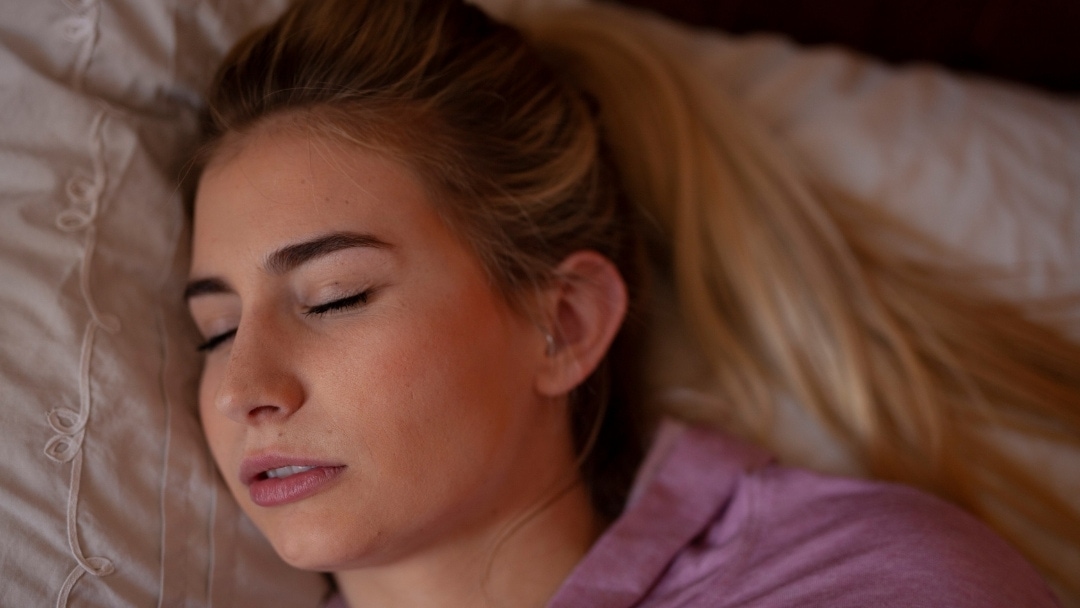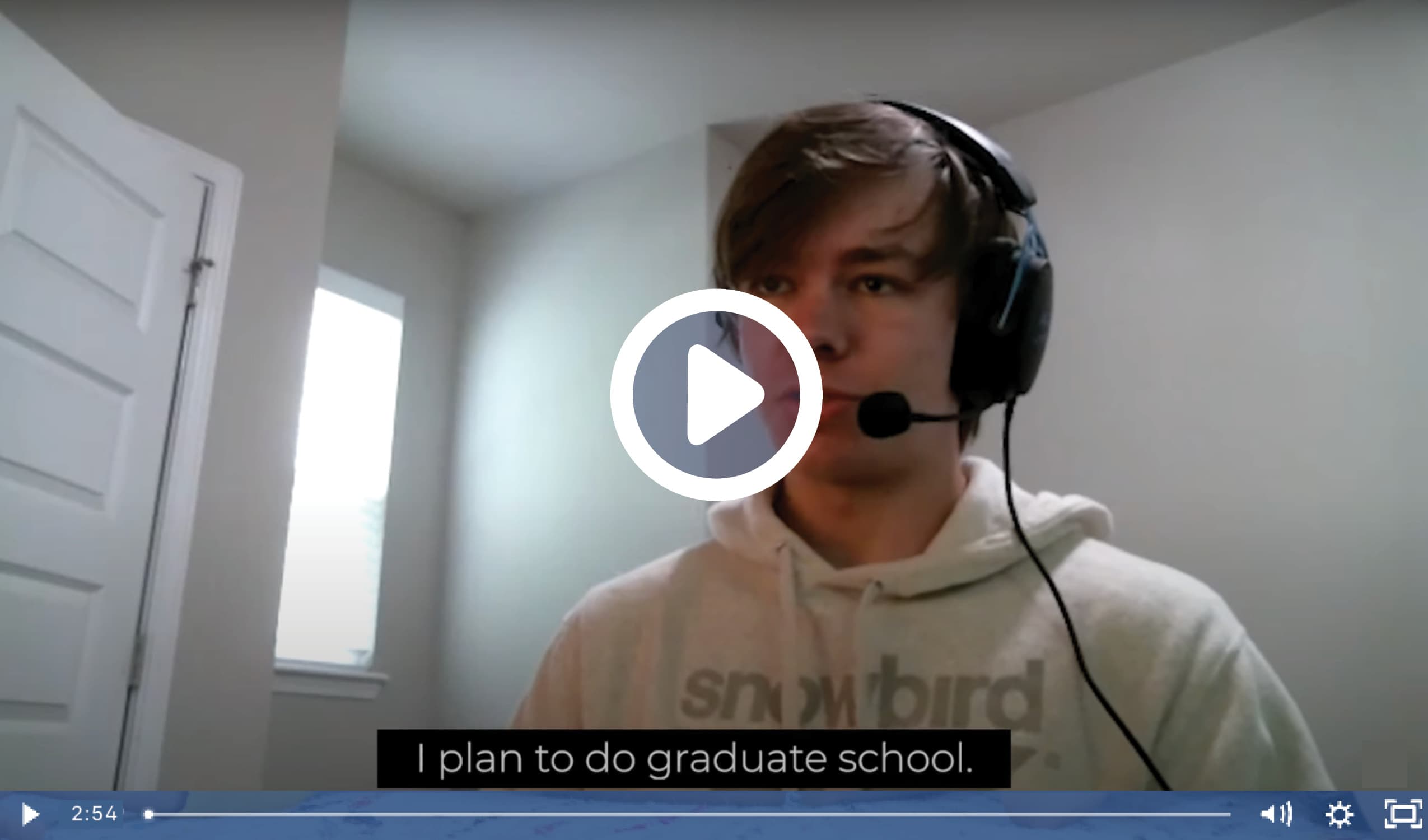When I saw my myofunctional therapist in March of 2021 for a functional assessment, she told me, very kindly, that I did not swallow or breathe correctly. I was thinking, “How do you get to 40 and not know how to breathe and swallow??” I could understand the swallow because I knew my tongue did tire easily and I mumbled, though I really tried hard to ENUNCIATE all my words… but breathing??
I have known Kathleen Elder for 16 of the 17 years I have been a dental hygienist. She was a hygienist and has been doing all things myofunctional for 20-plus years. I really valued all of her knowledge and trusted her. That started this whole journey. In no means is this medical advice. These are just observations in what I have noticed through my own personal journey.
It Started with Colic
It all started the day I was born, like so many others who suffer like I have. I am currently still on my journey of untangling a web I never even knew was being webbed. I was able to breastfeed but had colic and was very unhappy until I was six months old when I finally learned how to burp.
When you can not elevate your whole tongue to the roof of the mouth because you have a tongue tie, you will find yourself compensating and recruiting other muscles because you need to get the breast milk out. Only the front part of my tongue was able to elevate because the middle and back of my tongue was too restricted (tied) to the floor of the mouth. You compensate by recruiting the lips, cheek and neck muscles to work harder in the ways they shouldn’t because you need milk.
When the middle and back of the tongue are not in contact with the roof of the mouth you ingest more air…causing colic. You’re uncomfortable because you’re ingesting air. Then you learn how to burp, and eveybody’s happy!! But the swallow is still incorrect because it can not properly elevate.
Tongue Ties and Nitric Oxide
When you are nursing, you swallow then you breathe, over and over until you’re full or exhausted. Tongue ties are often at the root of swallowing and breathing disorders. When you do not have a relaxed swallowing pattern, your breathing patterns will be elevated, too. When you are not or cannot breathe through the nose, you are not producing nitric oxide (NO).
Nitric oxide is the most amazing and free thing our body makes. It is produced in the nose and paranasal sinuses. Nitric oxide turns on the parasympathetic nervous system which is the relax-and-digest portion of our nervous system. When we breathe through our mouths, we trigger the sympathetic nervous system that controls fight and flight. The nervous system gets stuck in the flight-and-flight response and doesn’t even know how to relax because it has never worked that way.
How the Tongue Shapes the Palate, and Why That’s Important
The tongue’s number one job is to shape and form the palate (roof of the mouth). If the tongue is too restricted to the floor, it is fairly impossible to shape a nice wide palate. The palate will still grow but it will grow high, causing a high, narrow palate. For some people, it encroaches into the nasal cavity, causing the septum to deviate. Lucky me!! I thought I was born with it. Nope.
Not only was I tongue tied, I also sucked my thumb until first grade. I had to get an appliance to help me stop sucking. So I had a double whammy of dysfunction all because I had inadvertently trained the tongue to lie on the floor of the mouth not the roof. I did not learn until March 2021 that I had a tongue tie and that the tongue (all of the tongue) should rest on the roof of the mouth.
You’d think they would teach you about that in dental hygiene school but no. We learn about teeth, gums, jaw bones, facial muscles but not where the tongue should rest?? So if I didn’t know these foundational things, then who would??
When the tongue is not able to contact the palate, we want to use thumbs and pacifiers. When the palate is stimulated by the tongue it releases endorphins that make us calm and happy. That is why we want the thumbs, fingers, pacies… because it helps us to relax.
Tongue Tie, Neck Pain and Posture
When the tongue is resting low instead of high, it not only affects the craniofacial growth, it also affects the cervical spine (the neck). A person’s posture is more upright when tongue is high versus low. We jut our head and neck out more to open our airway to breathe. This adds 5-15 pounds of pressure on the neck and will slowly cause the bones to move and also pinch nerves over time. Where the muscles go, the bones will follow.
Around four years ago when I went to a cervical spine chiropractor (I had seen different ones since childhood), he told me that he sees lots of dental professionals but I was different. The neck should curve like the letter C, and mine was a complete reverse C. Now I know that this is just not because I am a dental hygienist (although that certainly doesn’t help), it was because my neck started moving at a young age because of low tongue posture and mouth breathing.
You can see it in my kindergarten school picture. I was hunched over and my shoulders curved forward. I was a mouth breather with low resting tongue posture because I could only breathe out of one side of my nose. You can NOT breathe out of your mouth when your whole tongue is resting on the roof of the mouth.
In first grade, I got my appliance to help me stop sucking my thumb, and I threw up all over myself and the assistants taking my impression. Yep… I hated the dentist from that point forward. What I have noticed by being a dental hygienist for 17 years is that many people who are gaggers have tongue ties. This is not fact, just an observation. I also started getting headaches and ringing in my ears after I got my appliance.
Poor Grades and Nitric Oxide
Then second grade happened. My mom tried to talk with the teachers in kindergarten and first grade about holding me back, but they all thought I was ready to proceed. I have a late July birthday. Finally in second grade, it started catching up to me; Mrs. Dunn wanted to hold me back. I didn’t flunk like all my friends teased me about, but I was getting C’s and D’s.
I believe the reason I wasn’t thriving was because I was not getting adequate oxygen nor adequate sleep. Who can thrive with half oxygen? A child with half oxygen will still grow but not like the one one who gets full oxygen. I could only breathe out of the side of my nose only getting half of the oxygen bathed with nitric oxide.
It’s not always about quantity; it is also about quality. Breathing through the mouth causes cavities, gum disease, dry mouth and more plaque accumulation. It also inflames the oral tissues and the back of the throat. I’ve noticed and observed babies and kids that are always sick typically have their mouths open. The bacteria and viruses are going straight to the lungs and not being filtered by the nasal hairs and killed by nitric oxide.
Depression and Suicidal Ideation
I also remember that same year was the first time I remember just wanting to die. I was seven years old. The research shows that people who have disordered breathing patterns have more anxiety and depression.
Fast forward to age 26: I hit rock bottom. I was a dental hygienist and owned my own condo and car but still very depressed. I tried to take my life. Thank GOD I did not succeed. I was in the psych ward over Christmas. I got on some antidepressants which helped clear my mind. I remember thinking that “this should be in the drinking water.” That was when I started my uphill battle. That was when my life started changing for the better.
Two Surgeries
At 26 I had my first septum surgery, and they took out my tonsils and uvula and had it fixed properly at 34. Neither doctor told me that I needed to shut my mouth and breathe through my nose and why!! I was able to breathe better out of my nose after these surgeries. My sleep was somewhat improved.
From 26-40 I still was trying to figure out why I was always hot and why I was always tired, and I spent at least $20,000 to figure it out with no avail. One doctor alone was $8,000 out of pocket to draw my blood two times a week to check my epigenetics. I did his diet, his supplements and still did not feel better, but I knew something was wrong so I was willing to pay. A simple sleep study would have shown what was wrong.
Learning About Airway Health
It was not until February 2021 when I went to a dental conference on airway health that I found out that clenching and grinding was not just due to stress, which is what I was taught in dental hygiene school. When we do not get enough oxygen, we thrust our lower jaw forward to breathe, just like how you open the airway to do CPR. We are suffocating.
It could be because of underdeveloped jaws or becuase of swallowing and breathing dysfunctions or all of them. Lucky me, I have them all. I did my first sleep study during that conference, and I was on Ambien at the time… because I needed to sleep. My sleep study showed that I woke up 18 times an hour! You know you don’t feel good, and it is nice to see the data in black and white. This is not in my head. There IS something wrong. I am on the right track now!!
My question is: why??!! Why is my sleep so horrible? I knew I never felt rested, had brain fog, anxiety, yada yada yada. You just deal with it; it is nothing new.
TMJD: TemporoMandibular Joint Dysfunction
That is when I went to an airway-centered dentist for my jaw pain. I had TMJD for 20 years with clicking and popping in my jaws when I chewed and yawned. For the last three years, I struggled to even open my mouth wide enough to put a fork with food on it in my mouth, and it hurt to chew things. Shockingly, there is a high percentage of people who have TMJD who also have airway issues.
I didn’t know that the clicking and popping was happening because my maxilla (top jaw) was underdeveloped because of the tongue tie and thumbsucking. The mandible (lower jaw) grows based on the development, or underdevelopment in my case, of the maxilla. The lower arch is being trapped under the top arch.
My jaw would pop two times upon opening and two times upon closing. As soon as I had my tongue tie released, my jaw stopped popping!
Myofunctional Therapy
Myofunctional therapy is necessary before and after tongue-tie release. You have to train the tongue where to go and how to swallow before you release it. If you don’t, you could have worse problems. I met with my myofunctional therapist and also enrolled myself in the Academy of Orofacial Myofunctional Therapy (AOMT)’s intro course on myofunctional therapy in March.
I also did breathing re-education through the AOMT in December. At the root of snoring, sleep apnea, heart issues and so many other issues are swallowing and breathing disorders. I figured I needed to know about all of this to help myself but to also help my patients start connecting the dots as well.
My sleep improved a little after myofunctional therapy, but I knew how important it was to have the basic fundamentals of life (breathing and swallowing) down first. Those are the two basic functions you need to master when you come out of the womb. If you don’t, you WILL compensate. It took two and a half months for me just to train the tip of my tongue to rest on the roof of my mouth with myofunctional therapy.
Tongue-Tie Release
As soon as my tongue tie was released, the middle and back of my tongue automatically went up to the roof of my mouth. It could not physically go up there without the release. I also noticed that when I swallowed, my ears would pop open. When the tongue is in full contact with the palate, the negative pressure of the swallow opens the eustachian tubes. So for parents of kids that need tubes: Look a bit further and have a myofunctional therapist assess their swallow and look for tongue ties.
The tongue tie release is just the start. That is why EARLY intervention is best. No matter where you are in life, any progress is good. I’m glad I learned this at 40 instead of 50, but it would have been better off if I had learned it at 30.
Whole-Body Approach
Fascia is connective tissue that is all throughout your body, and a tongue tie is fascial tissue. If you are restricted in your mouth, you could be restricted all through your body to the tips of your toes. I have taken a whole-body approach to start unwinding this web by seeing a:
- Myofunctional therapist
- Airway-centered dentist to release my tongue tie
- Craniosacral therapist
- Breathing physical therapist
- Myofascial massage therapist
- Pelvic floor therapist
I have had to pay out of pocket for all of this. I have no problem doing that though because I need to fix this problem.
High Blood Pressure
I have high blood pressure. Now I know why. When you suffocate all night long, your heart has to pump harder to get you to wake up to roll over and start breathing. The heart is running a marathon all night long. This is why 40% to 80% of people who have sleep issues also have heart issues.
Research shows that someone who has Upper Airway Resistance Syndrome (UARS) has a higher mortality than someone who has sleep apnea (they stop breathing and oxygen levels in blood dip). UARS patients have a low arousal threshold and poor upper airway recruitment. Their oxygen levels dip, but they usually wake up before the oxygen in the blood is affected.
I will pay for this one way or another. I’m determined not to pay with my life. Look at genetics. My mom has a severe tongue tie but did not have the headaches, neck, back pain or poor sleep like I did. My dad had horrible sleep; he died at 66.
Sleep and the Glymphatic System
I started Dr. Stasha Gominack’s Right Sleep program in January 2022. She is a neurologist and found that if the gut health is not optimal with B vitamins, then you can not properly absorb vitamin D. We know there is a huge connection between the gut, brain, and sleep.
The average amount of REM (Rapid Eye Movement) sleep a person should be getting is 25%. REM sleep is so important because that is the only time the glymphatic system is activated. It takes protein buildup off the brain. Brain scans of a person who has poor sleep and someone who has Alzheimer’s are very similar. My REM sleep, with only a month of doing her program, went from the low end to what it should be.
Here are the results of my sleep studies, from first to last. AHI is Apnea Hypopnea Index; a number less than 5 is normal, and a score over 30 is severe. RDI is the AHI number plus RERA’s (Respiratory Effort Related Arousal). There is no index number for this. All over the world, sleep professionals are trying to change the laws to look at RDI instead of AHI. RDI is the number we should be looking at in addition to AHI, but insurance and many medical professionals do not look at it.
- RDI 18.2 / AHI 5.5 / REM 15.3% (Ambien)
- RDI 29.8 / AHI 10 / REM 7.7% (no Ambien, with mouth tape)
- RDI 17.5 /AHI 6.8 / REM 7.9% (tongue up, after myofunctional therapy)
- RDI 14.6 / AHI 1.9 / REM 6.9%(with mouth tape and after breathing training)
For the three consecutive nights after Dr. Gominack’s Right Sleep, here are my results:
- RDI 14 / AHI 6 / REM 22%
- RDI 17 / AHI 3 / REM 18%
- RDI 22 / AHI 5 / REM 27%
These sleep studies show improvement with doing myofunctional therapy, getting my tongue tie released, breathing re-education and gut-health protocols.
Underdeveloped Jaws
Now to fix my PROBLEM: Underdeveloped jaws. I am looking into an orthotropic or biomimetric appliance that will grow my jaws wider and more forward to make room for my tongue. The reason I wake up so frequently is because my jaws are not wide enough to house my tongue. My tongue falls back in my throat, I suffocate and then roll over. All night long. This is called Upper Airway Resistance Syndrome.
I have had braces two times as an adult. My teeth are beautiful. The jaws are another story. It’s like trying to park a Toyota Tundra truck into a one-car garage: It is not going to happen. That is why you need to see an orthodontist or dentist who is trained in airway issues. Even though my teeth look great, I still have tongue scalloping, which are the impressions of the teeth left on the tongue. The tongue is quite literally trying to get out of the airway so you can breathe, and that leaves those impressions on your tongue.
Key Takeaways
Here are the things I know now:
- Everybody should be breathing IN and OUT through their noses. We lose 42% of our hydration when we exhale out of our mouths. Try and never breathe out of your mouth. The more you use your nose, the better. Look into breathing re-education. You can change your breathing patterns, it just takes time. The best thing to do for kids is to make sure they are breathing through their nose at all times, if possible. I trained my two-year-old daughter because I observed her mouth breathing while watching TV, reading books, etc. I would gently say, “Jaylee, shut your mouth and breathe through your nose.” That beautiful nitric oxide that we ONLY produce through our nose not only kills bacteria, viruses and fungus, it also calms the nervous system and relaxes the heart and regulates pH balance in our bodies. There are many other benefits, but that is just to name a few. Breath training during the day when we are conscious will become a pattern which will hopefully take over when we are unconscious and sleeping. Very rarely do I see my daughter on her monitor breathing out of her mouth at night anymore. When I look back at pictures,her mouth was always open!
- The tongue tip, middle and back of the tongue should rest on the roof of your mouth.
- Get an evaluation from an airway-centered dentist who also has a myofunctional therapist they work closely with.
- Watch this video: Finding Connor Deegan. It’s an amazing transformation of a child when he saw an airway-centered dentist and got properly assessed for tongue tie.
- Do NOT assume that your pediatrician, ear-nose-and-throat doctor, dentist and dental hygienist are knowledgeable about tongue ties and airway issues. We are not. I had to spend a lot of money to gain this knowledge, and I learn more everyday.
- Listen to your gut. We know when something is not right. Keep searching for answers. My goal in life is to help my daughter not end up having the same struggles as I have had. I am finding a way to fix myself and helping any others along the way.
- Snoring and open mouth posture is NOT normal!! It is a huge RED flag there is something going on with their airway. Get looked at by an airway-centered dentist who has a myofunctional therapist working closely with them who can assess for tongue ties.
- Breastfeeding is best because the baby can get more tissue in the mouth, which activates more muscles and allows the jaws to grow wider and stronger. If breastfeeding is difficult, find a lactation consultant who is also trained in myofunctional therapy.
- Look on Facebook for tongue tie support groups in your area.
- Follow the following on on Facebook and Instagram:
* Buteyko Clinic. Nose unblocking exercises on Youtube.
* The Breathe Institute
* Halie Bulkin, a speech therapist and myofunctional therapist, She has a great podcast as well.
My take away for anyone reading this article is to get your kids help ASAP as well as yourself.
Still Looking for Answers?
Visit the Epidemic Answers Practitioner Directory to find a practitioner near you.
Join us inside our online membership community for parents, Healing Together, where you’ll find even more healing resources, expert guidance, and a community to support you every step of your child’s healing journey.
Sources & References
Amdo, T., et al. Somatic syndromes, insomnia, anxiety, and stress among sleep disordered breathing patients. Sleep Breath. 2016 May;20(2):759-68.
Berry, J., et al. A double-blind, randomized, controlled trial of tongue-tie division and its immediate effect on breastfeeding. Breastfeed Med. 2012 Jun;7(3):189-93.
Bussi, M.T., et al. Is ankyloglossia associated with obstructive sleep apnea? Braz J Otorhinolaryngol. 2021 Nov 5;S1808-8694(21)00181-6.
de Godoy, L.B., et al. Upper Airway Resistance Syndrome Patients Have Worse Sleep Quality Compared to Mild Obstructive Sleep Apnea. PLoS One. 2016; 11(5): e0156244.
Harari, D., et al. The effect of mouth breathing versus nasal breathing on dentofacial and craniofacial development in orthodontic patients. Laryngoscope. 2010 Oct;120(10):2089-93.
Huang, Y.S., et al. Short Lingual Frenulum and Obstructive Sleep Apnea in Children. Intl Journal of Clinical Pediatrics. 2015,1(1):1-4.
Reyes-Zúñiga, M., et al. Anxiety and depression symptoms in patients with sleep-disordered breathing. Open Respir Med J. 2012;6:97-103.
Siegel, S. Aerophagia Induced Reflux in Breastfeeding Infants With Ankyloglossia and Shortened Maxillary Labial Frenula (Tongue and Lip Tie). Int J Clin Pediatr. 2016;5(1):6-8.
Yeghiazarians, Y., et al. Obstructive Sleep Apnea and Cardiovascular Disease: A Scientific Statement From the American Heart Association. Circulation. 2021 Jul 20;144(3):e56-e67.
Resources
Books
Baxter, Richard, et al. Tongue-Tied: How a Tiny String Under the Tongue Impacts Nursing, Speech, Feeding, and More. Alabama Tongue-Tie Center, 2018.
Demerjian, G.G., et al. Temporomandibular Joint and Airway Disorders: A Translational Perspective. Springer, 2018.
Websites
Academy of Applied Myofunctional Sciences
Academy of Orofacial Myofunctional Therapy
Breastfeeding USA: Tell Me about Tongue Ties
Feeding, Speech and Mouth Development with Diane Bahr
International Affiliation of Tongue-tie Professionals
International Board Certified Lactation Consultant (IBCLC)
Lawrence A. Kotlow DDS, Pediatric Dentist
The Mommypotamus’ Guide to Identifying Tongue and Tongue/Lip Ties
Mouth Development: From High and Narrow Palate to Buccal and Tongue Ties
Post-Surgery Stretching and Massage Video by Lawrence Kotlow DDS
Tongue-Tie and Lip-Tie Support Network
What to Expect After Tongue-tie and Lip-tie Release
Tongue-Tie Support Groups for Parents:
Tongue-Tie Babies Support Group
Tongue-Tie Babies Facebook Group





